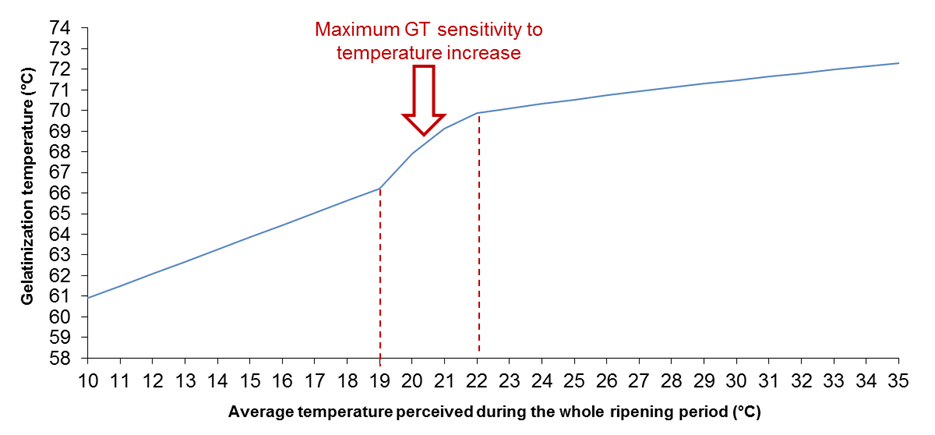This model calculates the Gelatinization temperature (GT) of rice starch as a function of the average air temperature experienced by the crop during the whole ripening period. The value of GT is then corrected by a factor accounting for the effect of maximum relative air humidity perceived by the crop in the field during the first 20 days after flowering.
The GT value (°C) at maturity (DVS = 3) is calculated as follow (Figure 1):

Where:
GTTavg (°C) is the Gelatinization temperature of rice starch calculated as function of average temperature perceived by the crop during the whole ripening period;
FRHmax (°C) represents the effect of average maximum relative air humidity experienced by the crop during the first 20 days after flowering on starch viscosity.

Figure 1. Gelatinization temperature (y-axis; °C) at maturity as function of the average temperature experienced by the rice crop during the whole ripening period (x-axis). The area between the red dotted lines represents the range of maximum gelatinization temperature relative increase due to temperature.
The GTTavg value (°C) is calculated as:

Where:
Tavg (°C) is the average temperature experienced by the crop during the whole ripening period;
Tmin (°C) is the temperature threshold below which the GT response to temperature is linear;
Tmax (°C) is the temperature threshold beyond which the GT response to temperature again becomes linear;
ai (0.5906 for Loto variety, 0.5666 for Gladio variety; unitless), bi (55 for Loto variety, 62 for Gladio variety; unitless), ci (-0.244 for Loto variety, -0.3345 for Gladio variety; unitless), di (11.2193 for Loto variety, 15.0361 for Gladio variety; unitless), ei (-58.8454 for Loto variety, -92.1536 for Gladio variety; unitless), gi (55.705 for Loto variety, 62.608 for Gladio variety; unitless), mi (0.0733 for Loto variety, 0.0648 for Gladio variety; unitless), are coefficients of the equations.
The effect of average maximum air relative humidity experienced by the crop during the first 20 days after flowering on starch viscosity is computed as follow:

Where:
RHmax (%) is the average maximum relative air humidity experienced by the crop during the first 20 days after flowering;
RHmaxTH (%) represents the threshold below which the maximum relative air humidity has no effect on GT;
ni (0.0048 for Loto variety, -0.1127 for Gladio variety; unitless), oi (-0.8449 for Loto variety, 22.146 for Gladio variety; unitless), pi (36.795 for Loto variety, -1086.9 for Gladio variety; unitless), qi (0.3074 for Loto variety, -1.522 for Gladio variety; unitless).
Created with the Personal Edition of HelpNDoc: Free EPub and documentation generator